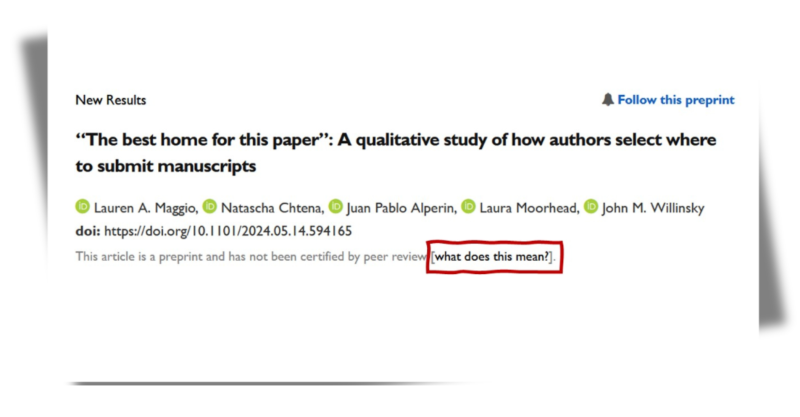
#59 – There’s a place for us, somewhere
Episode host: Lara Varpio

In this episode, Lara leads a discussion about how authors decide between journals when they are making submissions. With conversation about preprints, factors shaping decisions, and a curated set of resources every author needs, this is a not-to-be-missed episode.
Episode article
Maggio, L. A., Chtena, N., Alperin, J. P., Moorhead, L., & Willinsky, J. M. (2024). “The best home for this paper”: A qualitative study of how authors select where to submit manuscripts”.
Episode notes
Background
I picked this paper for three reasons:
- I want to talk about preprints as a phenomenon.
- The paper has good content.
- It gives me an excuse to share a set of resources aimed at helping authors get published!
Purpose
The purpose of this study was to explore how medical education authors decide which journals to submit to.
Methods
The authors conducted a qualitative study from a constructivist orientation (BONUS MARK) using focus groups. They wanted participants who were authors and editors working in medical education. So, for authors, they searched PubMed for journals published in 2022 in the Medical Education Journals List then, using a random number generated, selected 50 articles from the list and the first authors were contacted until they reached sufficient information power for their research aim. For editors, they approached the Editors in Chief and the deputy editors of the 24 journals on the Med Ed Journals list. They held five focus groups using video conferencing, analyzing the transcripts of those focus groups using code book thematic analysis. They used previous research from medical education that studied authors’ motivations for picking certain journals to publish in (i.e., Ginsburg 2016).
What is Codebook Thematic Analysis?
Thematic analysis is an umbrella term under which there are many varieties of thematic analysis. We often talk about reflexive thematic analysis from Braun and Clarke which is one approach under this umbrella. Another one is called codebook thematic analysis. That’s what the authors of this study used. The codebook approach has the researcher using a structured codebook, and that codebook is often predefined. This is a deductive approach but it can be augmented with inductive code and theme generation.
Results/Findings
The authors presented 6 factors influencing authors’ decisions about where to submit their papers for publication:
- Participants strongly considered the journal’s Impact. Impact was described in terms of the journal’s impact factor and in terms of who is the readership of a journal. Journal impact factor was noted as important because it was valued by some promotion and tenure considerations. But that consideration was balanced with wanting the right group of readers to be aware of their work.
- FIT also shaped the decision. Fit was all about determining if the paper aligned with the journal’s scope, its focus. Here, participants talked about looking to see what would be attractive to the journal. And here again, readership factored it. The authors noted that their paper had to fit the interests of the journal’s readership, it had to fit the conversations that were happening in the journal.
- Technical Factors like time to publication, rigid word limits, and where the journal is indexed were also considerations.
- Quality of the Peer Review was also discussed. Authors wanted to know that real experts who were positioned to give good feedback were going to be reviewing their papers. They also talked about how important it is for editors to weigh in when different reviewers offered different opinions.
- Open Access. It wasn’t a major factor, but it was a complimentary one. Open access was largely described as a benefit, but the Open Access fees were a REAL barrier for a lot of authors. They’d like their work to be open access, but many can’t afford that option.
- Finally, a new factor that the authors identified is Social Relationships. Participants—especially senior ones—talked about knowing the journal editors (i.e., on a first name basis). This influenced where they submitted their papers. But it also made it harder for junior scholars to break into journals because they didn’t have insider information.
Conclusions
While the findings in this paper aren’t revolutionary, they help us to understand why we make submissions to some journals over others.
Comments
This paper is a preprint—i.e., a version of a scholarly/academic manuscript that is shared via on online platform known as a preprint service. It is posted there BEFORE peer review and formal publication. There is MINIMAL screening — usually just to make sure nothing offensive is in there. Why would anyone disseminate their manuscript via preprint the work is accepted in a peer-reviewed journal? There are 4 good reasons:
- If you are worried about getting scooped, a preprint puts your name beside your findings FAST (like within minutes). It gets you first-past-the-post to publish findings (but are we worried about that in HPE???)
- In theory, you can get feedback from peers. I have 3 papers disseminated via post-publication review (which is NOT the same as preprints but they too are supposed to gather feedback from those who access the article). Mine are in MedEdPublish so I checked in on them. I only managed to access ONE, but that one was published in 2021. Thus far, not a single comment.
- Some grants want you to show early productivity so if you are under pressure to establish that you are writing up your findings and ready to publish, this could be a way of doing that.
- There is a very small body of evidence that papers that start off as preprints AND are then eventually published elsewhere have higher Altmetric scores.
I also recognize that this paper is about why authors submit to journals. But the other side of that coin is really important: why do some papers get accepted and others don’t? There are resources to help/inform your writing. I curated some of my favorite resources that really WILL help you get your paper accepted. See list of recommended references below.
References
Advice for authors from the editors of Perspectives on Medical Education: Getting your research published. (2018) Varpio, L., Driessen, E., Maggio, L., Lingard, L., Winston, K., Kulasegaram, K., Nagler, A., Cleland, J., Schönrock-Adema, J., Paradis, E., Mørcke, A. M., Hu, W., Hay, M., & Tolsgaard, M. G. Perspectives on medical education, 7(6), 343–347.
Altmetric Scores, Citations, and Publication of Studies Posted as Preprints. (2018). Serghiou, S., & Ioannidis, J. P. A. JAMA, 319(4), 402.
Delineating the field of medical education: Bibliometric research approach(es). (2022). Maggio, L. A., Ninkov, A., Frank, J. R., Costello, J. A., & Artino, A. R., Jr Medical education, 56(4), 387–394.
Good advice from the deputy editors of Medical Education. (2012). Medical Education, 46(9), 828–829.
Good advice from the deputy editors of Medical Education: The sequel. (2022). Medical Education, 56(5), 468–469.
Good advice from authors working in under‐represented countries. (2023). Du, X., Ibiapina, C. D. C., Kassab, S. E., & Yan, A. Medical Education, 57(6), 493–495.
Nimmon, L. (2024). The complexity of physician power. Science, 384(6697), 742–743.
The Inside Scoop: What We Learnt About Getting into Academic Publishing During Our Editorial Internship. (2023). H. R, C., & L, G. Medical Science Educator, 34(2), 439–444.
Writing Author Response Letters That Get Editors to “Yes”. (2019). Sullivan, G. M., Simpson, D., Yarris, L. M., & Artino, A. R. Journal of Graduate Medical Education, 11(2), 119–123.
The Writer’s Craft Collection: Resources to enhance your academic writing
Writer’s Craft publications that aim to support scholars to improve their academic writing. Perspectives on Medical Education.
Video: What are preprints? – Science Communication Lab (YouTube)
Website
What are Preprints and Why Do We Need Them? (UCSF Library). 2024, April 11, UCSF Library Help Center.

0 comments